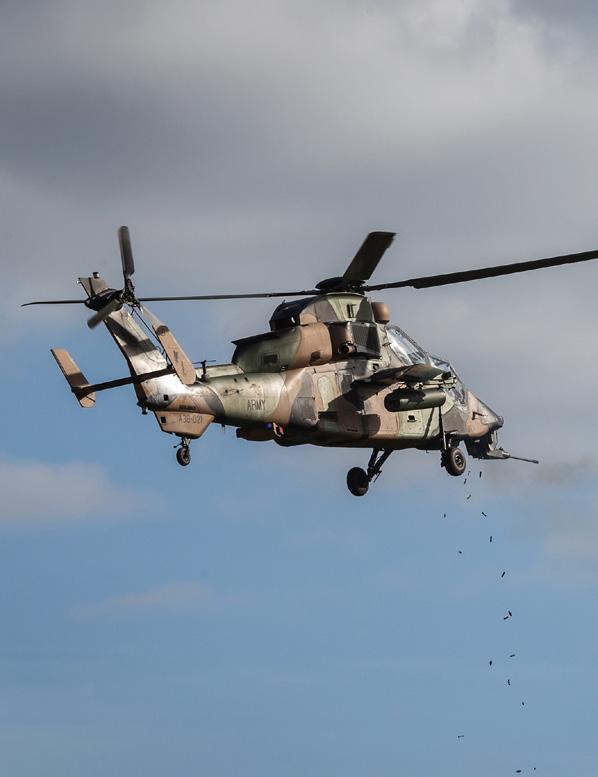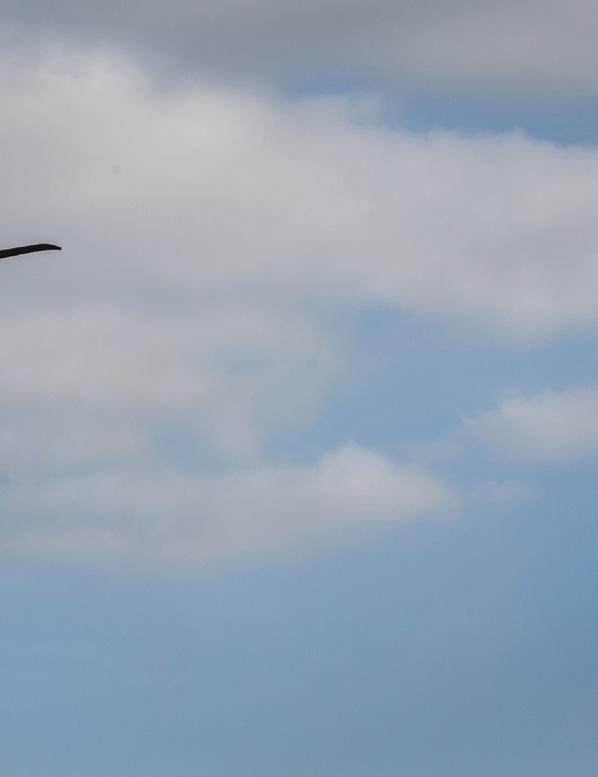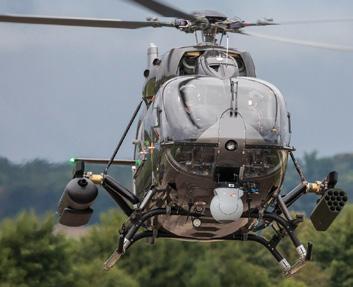
10 minute read
TARGET TIGER Airbus proposes Tiger ARH upgrade
from ADBR JAN-FEB 2020
by adbr5
TARGET TIGER
Airbus has proposed a novel solution for the Australian Army’s LAND 4503 requirement for 29 new armed reconnaissance helicopters (ARH), in contrast to product-driven solutions offered by Boeing and Bell. It is proposing to not only extend the life of the existing 22 Tigers and enhance them with new technologies and capabilities, but to augment them with seven H145M light multirole helicopters to achieve the requirement for 29 airframes.
Advertisement
Airbus says its unsolicited proposal will exceed the Army’s operational requirements at a fraction of the cost of acquiring 29 new build helicopters. This claim is based on its ability to deliver its bid for less than $1 billion, compared with an estimated $3- $4 billion for 29 new Apaches or Vipers including all the necessary unique support and training infrastructure, spares and stores.
Tiger is now performing well after a protracted and troubled introduction to Army service, but past poor performance has created a legacy of distrust in some areas of the Army and its political decision makers.
That distrust manifested in the 2016 Defence White Paper which declared that the government would replace the 22 Tigers with a new armed reconnaissance capability from the mid-2020s.
Airbus’s bid could see Tiger service life extended out to 2040 and potentially beyond. It would add upgrades such as improved connectivity and electronic warfare, and recognises that an armed reconnaissance capability need not be delivered exclusively by dedicated ARH platforms.

Airbus helicopter campaigns lead Laurie Alexander told Australian media in December that Airbus wanted to keep Tiger in service.
“We want to operate that aircraft, fly it safely, credibly beyond 2040, and we also want to renew it,” he said. “We want to target those operationally desirable, needed upgrades for the Tiger to ensure it remains operationally credible in a modern battlespace.”
Australia chose the (then) Eurocopter Tiger as its successful Project AIR 87 Armed Reconnaissance Helicopter in 2001.
It was a huge advance on what came before – the Bell 206B Kiowa and the UH-1H Iroquois ‘Bushranger’. The key sensor on the unarmed Kiowa was an observer with binoculars, while the Bushranger was limited to a door gun and unguided, forward firing rockets or gun pods.
When introduced, Tiger was far and away the most complex weapons system in Army service.
The last of the 22 Tigers was delivered in 2011, but full operational capability (FOC) wasn’t declared until April 2016. Alexander said the review of the Tiger program in 2014 and an agreement between Airbus and the Commonwealth laid the groundwork for improvements.
“Unfortunately, those improvements weren’t well realised before the White Paper was released in 2016,” Alexander said. “But they are now being realised. We are seeing the benefits of those changes now.” Airbus Asia-Pacific managing director (and CASG’s former Head of Helicopter Systems Division) Andrew Matthewson said Airbus realised it needed to do a lot more work.
TIGER UPGRADE
Airbus proposes a radical plan to meet the LAND 4503 ARH requirement TARGET TIGER
“Some army officers today still think Tiger is where it was 10 years ago, but it’s not there at all,” Matthewson said. “It is now performing exceptionally well.
“We invested pretty heavily in root cause analysis between ARH and MRH, and what we needed to do on our end to improve. ARH came up with a whole bunch of areas we needed to address, and this is an ongoing program.”
On its side, Army reduced its overly ambitious annual target of 7,000 flying hours across the fleet to 4,500, allowing more time for maintenance and training which has subsequently lifted aircraft availability.
Better management cut costs, now down 30 per cent from $41,000 to around $27-28,000 per flying hour. That still sounds like a lot, but it comprises every cost, including maintenance, training, and the joint system program office. So how does that cost compare to rival platforms?
“For the best reference, talk to the Brits,” Matthewson said. “They are happy to tell you.”
Figures quoted in the UK media in 2013 put the hourly operating cost of each of the UK Army’s 66 Apaches at £46,000 (A$89,000) – substantially more than even the Tornado strike aircraft.
Alexander said Airbus examined Tiger to assess what it did well and what would need to be done to keep the aircraft flying for up to two more decades. Tigers operated by the French Army – now in the HAD configuration against the original HAP which most closely resembles Australia’s ARH – feature enhanced MTR390 engines with power increased by 14 per cent, a consequence of performance issues at high altitude in Afghanistan.
Airbus says it sees no need for Australia to reengine its Tigers, with Alexander saying Australian Tigers have sufficient power, delivering a good compromise between power and fuel economy.
French, German and Spanish Tigers are currently configured at what Airbus designates ‘Standard 2’, and are to be upgraded to ‘Standard 3’ by 2025 with a range of enhancements to weapons systems, sensors and connectivity. Airbus isn’t proposing that Australian Tigers be upgraded to this standard, although some elements could be of interest if the Tigers are retained.
For example, the Israeli Spike LR anti-tank guided missile entering Australian Army service could be adapted to Tiger as integration work has already been undertaken for Spain.
Airbus says Tiger’s low weight – six tonnes fully loaded against eight tonnes for an Apache and 8.4 tonnes for Viper – makes it more agile and manoeuvrable, while its all-composites structure with a lower radar signature makes it more survivable.
“But with any modern battlefield, threats levels will develop over time,” Alexander said. “EW at the moment is good, but at some stage in the future you are going to have to factor in upgrading the EW. This is a no-brainer.”
Airbus also proposes installing high-definition cockpit multi-function displays (MFDs) which will enhance the ability of the aircraft’s battle captain to make better use of data from the Safran Strix EO/IR sight mounted above the cabin.
At present, that data is compressed for display on the existing low-resolution MFDs, so some detail is lost. Other Tiger capabilities are already world-class, such as the Thales Top Owl helmet which displays flight and targeting data on the inside of the visor. French Tiger pilots describe Top Owl as a true 5th generation capability, up there with the much-vaunted HMD helmets worn by F-35 pilots, and better than anything available on other attack helicopters.
One of the key criticisms of Tiger to date has been its lack of a datalink giving it poor connectivity to other platforms and systems across the battlespace. But Airbus says Apache has only recently achieved this capability while it is programmed for a future upgrade of the Viper.
As delivered, Australia’s Tigers came with Eurogrid – one of the first digital battlespace communications tools – which was developed in Europe to allow a Tiger to talk to a ground station in a command post and share overlays and maps. Eurogrid was originally considered quite a capable system, but its shortcomings were soon apparent in that it couldn’t talk to other aircraft and systems. ‘When introduced, Tiger was far and away the most complex weapons system in Army service.’

Airbus’s proposal includes seven armed H145M helicopters to meet the requirement for 29 machines. AIRBUS
Tiger is now cleared to operate from the RAN’s LHDs, and was recently proven operationally during Operation Bushfire Assist. DEFENCE
In 2012 Airbus conducted a Tiger interoperability study, investigating the integration of other capabilities such as VMF (variable message format), Link 16, and the Army’s Battle Management System Torch developed by Elbit.
“The outcome of that was that the Commonwealth decided to integrate the interim tactical datalink (ITDL) so Army aviation could learn how the tactical datalink would work and operate on an army aircraft,” Alexander said.
This is a new capability which allows Tigers fitted with ITDL to talk to BMS Torch, but not all are so equipped. “It is really about doing by learning,” Alexander added. “They can actually have that capability, but there is no-one to talk to in Darwin (where Tiger is based). It is only used when they go on exercises, so it doesn’t need to be in every aircraft.”
However, more will be needed for full interoperability with current and emerging systems such as the RAAF’s AIR 7003 Predator and other unmanned aircraft. Thus, Airbus is proposing integration of a full Link 16 capability which would give Tiger access to other ADF systems, and new capabilities such as manned-unmanned teaming (MUM-T) level of interoperability (LOI) two, expected to be specified in the LAND 4503 requirements.
NATO specifies five levels of MUM-T complexity. Level one is the basic minimum, with processed imagery pushed out to the platform from the network. Level five gives the platform complete control of the platform including even launch and recovery.
Level two allows the platform to pull imagery directly from the source UAV and would, for example, allow a Tiger to take imagery from a forward UAV, scouting possible enemy positions, without getting into harm’s way.

Use a Tiger on LHD pic
THE LAND 2097 LINK The complementary H145M Airbus proposal is based on the twin-engined civil BK117/EC145/H145 airframe.
In H145M form it is available with a wide range of equipment, including a Safran Europhile 410 electrooptical/infrared (EO/IR) sensor, and a variety of air-tosurface weapons. It also adds the additional advantage over Apache or Viper of being able to carry several passenger or stores.
Airbus is also pitching H145M for Project LAND 2097 Phase 4, slated to deliver 16 light utility helicopters for use by Army’s 6 Aviation Regiment (6Avn) in the special forces support role for domestic and maritime counter-terrorism, special operational recovery, and combat search and rescue.
More than 1,300 BK117/EC145/H145s are in service around the world, including 400 US Army UH-72 Lakota light utility helicopters, variants of the EC145.
With Airbus’s ‘HForce’ weapons suite, the aircraft can be incrementally armed with gun and rocket pods, or precision air-to-ground missiles such as Hellfire or Spike on stub wing hardpoints.
It can carry 10 passengers in high density seating configuration, but for military use six fully equipped soldiers is a more comfortable fit. To make these new aircraft fully deployable, Defence has specified that four must be transportable aboard a C-17A Globemaster III transport, and rapidly unloaded and configured for deployed operations.
If the H145M is not selected for LAND 2097, Airbus says it could retain its proposed Tiger/H145M mix for LAND 4503, or could offer seven more Tigers to achieve the requirement of 29 airframes, albeit at a cost.
Obviously if another type is selected for LAND 2097, that would make the Tiger/H145M proposal less appealing. The main goal of the AIR 9000 program was to reduce the number of ADF helicopters types from nine to five.
And while the Seasprite program disaster, and continuing delays in integrating the MRH 90 into the special operations role have seen that plan derailed, the last thing the ADF would want is yet another helicopter type.
The RFT for LAND 2097 Phase 4 is expected to be released in conjunction with Gate 0 before the end of March, with a Gate 1 down-select expected to be achieved by the end of the year and acquisition starting in 2022-23.
The decisions for LAND 4503 are scheduled to follow a few months after, with IOC of 12 aircraft set for 2026, and FOC in 2028.
So, for Airbus, a key component of its proposal is the potential saving to the Commonwealth – estimated to be $2-$3 billion – as well as a more rapid path to FOC because Tiger already has an established sustainment and training system in place.
The Defence Integrated Investment Plan (IIP) cites a LAND 4503 program cost of $5-6 billion over the period 2021-2030, so any funding not spent on new attack helicopters could be directed to other capabilities during a period that will require increased defence spending.










